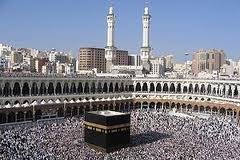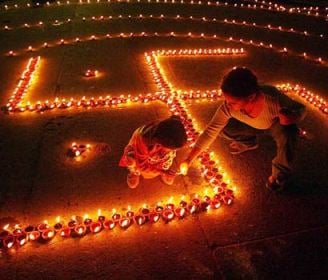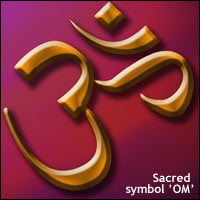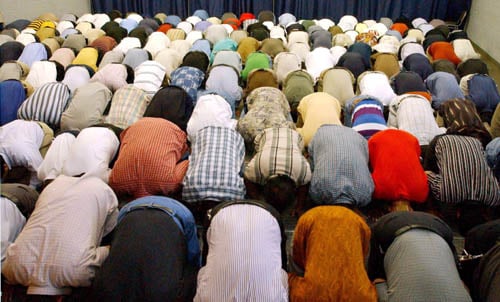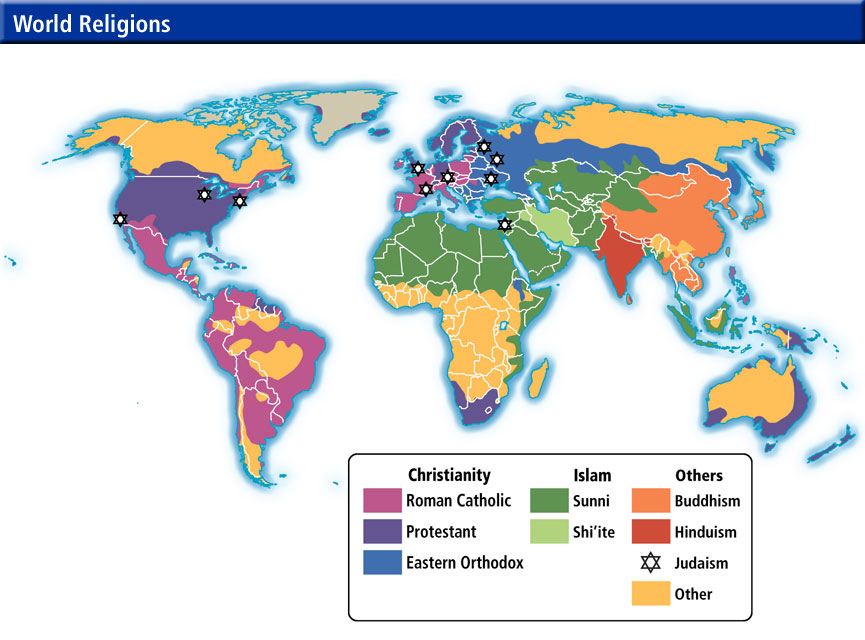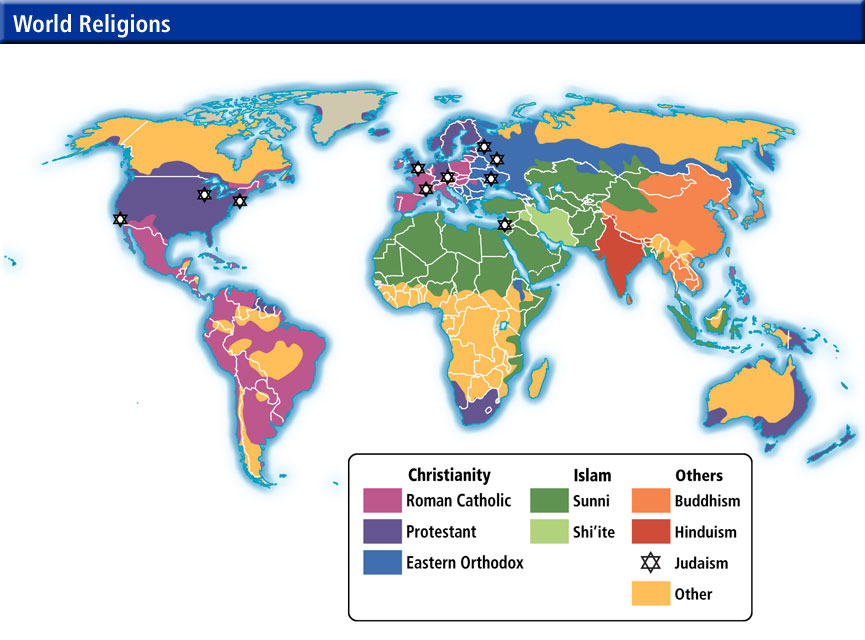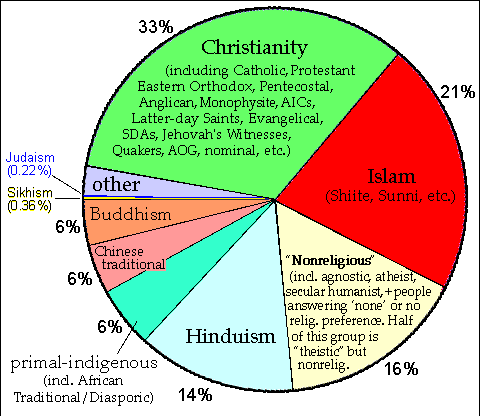The Ultimate World Religions Test
(455).jpg)
Welcome to the Ultimate World Religions Test! What do you know about religions all over the world? Take the " The Ultimate World Religions Test" quiz to find out. Religion is one of the most exciting topics globally, regardless of your stance and beliefs, because it analyses all of the things that give us hope, devotion, and faith. It guides morality and has been an ultimate source of power, love, and sacrifice. Pick the correct option to get a good score. Good Luck!
- 1.
A follower of Islam is called a __________________________.
- A.
Brahman
- B.
Missionary
- C.
Muslim
- D.
Hindi
Correct Answer
C. MuslimExplanation
A follower of Islam is called a Muslim. Islam is a religion founded by Prophet Muhammad in the 7th century and its followers are known as Muslims. Muslims believe in the teachings of the Quran and follow the five pillars of Islam, which include faith in Allah, prayer, fasting, charity, and pilgrimage to Mecca. The term "Muslim" comes from the Arabic word "salam" which means peace, indicating the importance of peace and submission to Allah in the Islamic faith.Rate this question:
-
- 2.
The founder of Islam is ___________________.
- A.
Siddhartha Gautama
- B.
Abraham
- C.
Jesus
- D.
Muhammad
Correct Answer
D. MuhammadExplanation
Muhammad is the founder of Islam. He was born in Mecca, Saudi Arabia in the year 570 AD. At the age of 40, he received revelations from God through the angel Gabriel, which became the basis for the Quran, the holy book of Islam. Muhammad preached monotheism and called for social justice, equality, and compassion. He established the first Islamic state in Medina and his teachings formed the foundation of the Islamic faith, making him the central figure in the religion.Rate this question:
-
- 3.
The belief in one god is called ________________.
- A.
Monotheism
- B.
Polytheism
- C.
Religion
Correct Answer
A. MonotheismExplanation
Monotheism refers to the belief in one god. This belief system contrasts with polytheism, which involves the belief in multiple gods, and religion, which is a broader term encompassing various belief systems and practices.Rate this question:
-
- 4.
The sacred text (holy book) of the Christians is the _______________.
- A.
Qu'ran or Koran
- B.
Bible
- C.
The Vedas
- D.
The Torah
Correct Answer
B. BibleExplanation
The Bible is considered the sacred text or holy book of Christians. It is a collection of religious texts and scriptures that include the Old Testament and the New Testament. The Old Testament contains religious writings that are also recognized by Judaism, while the New Testament focuses on the life and teachings of Jesus Christ. Christians believe that the Bible is the inspired word of God and serves as a guide for their faith and practices.Rate this question:
-
- 5.
The founder of Buddhism is ______________________.
- A.
Siddhartha Gautama
- B.
Jesus
- C.
Muhammad
- D.
Abraham
Correct Answer
A. Siddhartha GautamaExplanation
Siddhartha Gautama is the correct answer because he is widely recognized as the founder of Buddhism. Born in ancient India, Gautama became known as the Buddha after attaining enlightenment. He taught the principles of Buddhism, including the Four Noble Truths and the Eightfold Path, which became the foundation of the religion. His teachings spread throughout Asia and continue to influence millions of people today.Rate this question:
-
- 6.
Some of the sacred texts of the Hindus include __________________.
- A.
The Torah and the Hebrew Bible
- B.
The Qu'ran and the teachings Abraham
- C.
The Vedas, Mahabharata, and the Upanishads
Correct Answer
C. The Vedas, Mahabharata, and the UpanishadsExplanation
The Vedas, Mahabharata, and the Upanishads are considered sacred texts of the Hindus. The Vedas are the oldest and most authoritative texts, containing hymns, rituals, and philosophical teachings. The Mahabharata is an epic that narrates the story of the Kurukshetra War and includes important teachings such as the Bhagavad Gita. The Upanishads are philosophical texts that explore concepts like the nature of reality and the self. These texts hold significant religious and spiritual importance for Hindus and are studied, revered, and followed by millions of people.Rate this question:
-
- 7.
The sacred text (holy book) for followers of Islam is _______________.
- A.
Bible
- B.
The Vedas
- C.
Qu'ran or Koran
- D.
The Torah
Correct Answer
C. Qu'ran or KoranExplanation
The sacred text for followers of Islam is the Qu'ran or Koran. The Qu'ran is believed to be the word of God as revealed to the Prophet Muhammad by the angel Gabriel. It serves as the ultimate guide for Muslims, containing teachings on various aspects of life, including faith, morality, and social justice. The Qu'ran is considered the literal and unaltered word of God and is recited and memorized by Muslims worldwide. It is the central religious text of Islam and holds immense significance in shaping the beliefs and practices of Muslims.Rate this question:
-
- 8.
Which is NOT one of the Five Pillars of Faith associated with Islam?
- A.
Give to charity
- B.
Pray 5 x's per day
- C.
Travel to Mecca at least once in your lifetime
- D.
Become a missionary in a foreign land
Correct Answer
D. Become a missionary in a foreign landExplanation
The correct answer is "Become a missionary in a foreign land." This is not one of the Five Pillars of Faith associated with Islam. The Five Pillars of Faith include giving to charity, praying five times a day, traveling to Mecca at least once in your lifetime (Hajj), fasting during the month of Ramadan, and declaring faith in Allah and Muhammad as his prophet (Shahada). Becoming a missionary in a foreign land is not a requirement or pillar of the Islamic faith.Rate this question:
-
- 9.
The Five Pillars of Faith which include praying five times a day and making a pilgrimage to what holy city? Muslims also face this city when they pray.
- A.
Mecca
- B.
Jerusalem
- C.
Istanbul
- D.
Beijing
Correct Answer
A. MeccaExplanation
Muslims are required to perform the Five Pillars of Faith, one of which is making a pilgrimage to the holy city of Mecca. This pilgrimage, known as Hajj, is a mandatory religious duty for Muslims who are physically and financially capable. Additionally, Muslims face towards Mecca when they pray, regardless of their location in the world. Mecca holds great significance in Islam as it is the birthplace of the Prophet Muhammad and the location of the Kaaba, the holiest site in Islam.Rate this question:
-
- 10.
All three major monotheistic religions developed in this region.
- A.
Europe
- B.
North America
- C.
The Middle East or Southwest Asia
- D.
China
Correct Answer
C. The Middle East or Southwest AsiaExplanation
The correct answer is The Middle East or Southwest Asia. This region is known for being the birthplace and center of three major monotheistic religions: Judaism, Christianity, and Islam. These religions have had a significant impact on the culture, history, and development of the region. The Middle East or Southwest Asia is also home to important religious sites such as Jerusalem, Mecca, and Medina.Rate this question:
-
- 11.
Hinduism and Buddhism both developed in this area.
- A.
Middle East
- B.
Europe
- C.
India
- D.
Italy
Correct Answer
C. IndiaExplanation
Hinduism and Buddhism both developed in India. Hinduism originated in the ancient Indus Valley civilization and evolved over thousands of years, becoming the dominant religion of the Indian subcontinent. Buddhism, founded by Siddhartha Gautama (Buddha), also emerged in India and gained significant popularity before spreading to other parts of Asia. Therefore, India is the correct answer as it is the geographical region where both religions originated and flourished.Rate this question:
-
- 12.
Judaism, Christianity, and Islam all ____________________________
- A.
Believe in many divine Gods
- B.
Worship only one God
- C.
Follow the teachings of the Qu'ran
- D.
Believe Jesus was the son of God
Correct Answer
B. Worship only one GodExplanation
Judaism, Christianity, and Islam all worship only one God. These three religions are monotheistic, meaning they believe in the existence of a single, supreme deity. They reject the idea of multiple gods and emphasize the worship and devotion to a singular divine being. This shared belief in monotheism is one of the fundamental similarities among these three religions, despite their differences in doctrines, scriptures, and practices.Rate this question:
-
- 13.
The Torah is the sacred writing (holy book) for which religion?
- A.
Judaism
- B.
Christianity
- C.
Islam
- D.
None of the above
Correct Answer
A. JudaismExplanation
The Torah is the sacred writing for Judaism. It is the central text of the Jewish religion, containing the laws, teachings, and history of the Jewish people. It is considered the word of God and is highly revered and studied by Jewish individuals. The Torah is comprised of the five books of Moses, also known as the Pentateuch, which are Genesis, Exodus, Leviticus, Numbers, and Deuteronomy. These books contain the foundational beliefs and practices of Judaism, making it clear that the correct answer is Judaism.Rate this question:
-
- 14.
The belief that the soul never dies but is continually reborn or reincarnated is associated with which religion?
- A.
Islam
- B.
Christianity
- C.
Judaism
- D.
Hinduism and Buddhism
Correct Answer
D. Hinduism and BuddhismExplanation
Hinduism and Buddhism are associated with the belief in reincarnation, where the soul is believed to be reborn in a new body after death. This concept is central to both religions, as they believe in the cycle of birth, death, and rebirth, known as samsara. In Hinduism, this cycle is influenced by karma, while in Buddhism, it is seen as a means to attain enlightenment and escape suffering. Both religions emphasize the importance of breaking free from this cycle through spiritual practices and self-realization.Rate this question:
-
- 15.
Following the Eightfold Path and the Four Noble Truths to achieve enlightenment is associated with which religion?
- A.
Buddhism
- B.
Hinduism
- C.
Islam
- D.
Christianity
Correct Answer
A. BuddhismExplanation
Following the Eightfold Path and the Four Noble Truths are key teachings in Buddhism. The Eightfold Path consists of guidelines for ethical conduct, mental discipline, and wisdom that lead to the cessation of suffering and the attainment of enlightenment. The Four Noble Truths are fundamental teachings that explain the nature of suffering and provide a path to its cessation. Therefore, the correct answer is Buddhism.Rate this question:
-
- 16.
Diwali, the festival of Lights is important to which religion?
- A.
Christianity
- B.
Judaism
- C.
Hinduism
Correct Answer
C. HinduismExplanation
Diwali is a significant festival celebrated by Hindus. It is also known as the festival of lights and is one of the most important and widely celebrated festivals in Hinduism. During Diwali, Hindus light oil lamps, decorate their homes, and participate in various religious rituals and festivities. It marks the victory of light over darkness and good over evil. Therefore, the correct answer is Hinduism.Rate this question:
-
- 17.
The following symbol represents what religion?
- A.
Christianity
- B.
Hinduism
- C.
Islam
- D.
Judaism
Correct Answer
C. IslamExplanation
The given symbol represents Islam. Islam is a monotheistic religion that originated in the 7th century CE in the Arabian Peninsula. The symbol shown is the crescent moon and star, which is commonly associated with Islam and is often used to represent the religion. The crescent moon is a symbol of the lunar calendar, while the star represents the divine light and guidance in Islam.Rate this question:
-
- 18.
The Star of David honors King David who ruled the kingdom of Israel from 1000-962 BC. This is associated with which religion?
- A.
Judaism
- B.
Christianity
- C.
Islam
- D.
Hinduism
Correct Answer
A. JudaismExplanation
The Star of David is a symbol that is closely associated with Judaism. It is believed to honor King David, who was an important figure in Jewish history and ruled the kingdom of Israel in ancient times. The Star of David is often seen as a representation of the Jewish faith and is prominently displayed on synagogues, Jewish religious texts, and the flag of Israel.Rate this question:
-
- 19.
The "Om" symbol represents the religion of _________________
- A.
Buddhism
- B.
Hinduism
- C.
Islam
- D.
Judaism
Correct Answer
B. HinduismExplanation
The "Om" symbol is a sacred sound and a spiritual icon in Hinduism. It is considered the most important symbol in Hinduism and represents the essence of the ultimate reality, Brahman. The symbol is often chanted or meditated upon in Hindu rituals and is believed to connect the individual soul with the universal soul. It is also associated with various Hindu deities and is considered a powerful mantra. Therefore, the correct answer is Hinduism.Rate this question:
-
- 20.
Ramadan is the holy month of fasting for which religion?
- A.
Christianity
- B.
Hinduism
- C.
Islam
Correct Answer
C. IslamExplanation
Ramadan is the holy month of fasting for Islam. During this month, Muslims around the world observe fasting from dawn to sunset as a way of purifying the soul, practicing self-discipline, and showing devotion to Allah. It is considered one of the Five Pillars of Islam and holds great significance in the Islamic faith. Therefore, the correct answer is Islam.Rate this question:
-
- 21.
This religion believes that the main god and creator, Brahman, takes the form of three deities. There are hundreds of other gods in this religion. What religion is this?
- A.
Judaism
- B.
Hinduism
- C.
Islam
- D.
Buddhism
Correct Answer
B. HinduismExplanation
Hinduism is the correct answer because it is a religion that believes in the main god and creator, Brahman, who takes the form of three deities. Hinduism also has a vast pantheon of hundreds of other gods.Rate this question:
-
- 22.
The cross and the wheel of Dharma are a symbol for what two faiths, respectively?
- A.
Hinduism and Islam
- B.
Christianity and Islam
- C.
Christianity and Buddhism
- D.
Judaism and Hinduism
Correct Answer
C. Christianity and BuddhismExplanation
The cross is a symbol of Christianity, representing the crucifixion of Jesus Christ. The wheel of Dharma is a symbol of Buddhism, representing the teachings and path to enlightenment. Therefore, the cross and the wheel of Dharma are symbols for Christianity and Buddhism, respectively.Rate this question:
-
- 23.
The predominant religion in the Middle East (located between Africa and Asia), including countries such as Saudi Arabia and Iraq is:
- A.
Islam--Sunni
- B.
Christianity--Protestant
- C.
Hinduism
- D.
Buddhism
Correct Answer
A. Islam--SunniExplanation
The correct answer is Islam--Sunni. The Middle East is predominantly Muslim, with Islam being the major religion in countries like Saudi Arabia and Iraq. Within Islam, there are different sects, and Sunni is the largest sect, followed by Shia. Sunni Muslims make up the majority of the Muslim population in the Middle East.Rate this question:
-
- 24.
The predominant religion in South America is:
- A.
Christianity--Roman Catholic
- B.
Islam--Sunni
- C.
Christianity--Protestant
- D.
Buddhism
Correct Answer
A. Christianity--Roman CatholicExplanation
The predominant religion in South America is Christianity, specifically Roman Catholicism. This is because of the historical influence of Spanish and Portuguese colonization in the region, which brought Catholicism as the main religion. Today, a significant majority of South Americans identify as Roman Catholics, with the religion playing a central role in their culture, traditions, and daily lives.Rate this question:
-
- 25.
The predominant religion in East Asia, including Japan and China, and South Asian countries such as Vietnam, Cambodia, and Thailand is:
- A.
Christianity--Catholic
- B.
Islam--Sunni
- C.
Buddhism
- D.
Hinduism
Correct Answer
C. BuddhismExplanation
Buddhism is the correct answer because it is the predominant religion in East Asia, including countries like Japan and China, as well as South Asian countries such as Vietnam, Cambodia, and Thailand. Buddhism originated in India and then spread to other parts of Asia, gaining significant followers and influence in these regions. It is characterized by its teachings on enlightenment, karma, and the path to liberation from suffering. Buddhism has had a profound impact on the culture, art, and philosophy of these countries, making it the dominant religion in the region.Rate this question:
-
- 26.
The predominant religion in India is:
- A.
Islam--Sunni
- B.
Buddhism
- C.
Judaism
- D.
Hinduism
Correct Answer
D. HinduismExplanation
Hinduism is the correct answer because it is the largest and most widely practiced religion in India. It has deep historical and cultural roots in the country, with a majority of the population identifying as Hindus. Hinduism encompasses a wide range of beliefs and practices, including worship of multiple gods and goddesses, rituals, and spiritual philosophies. It has shaped Indian society, art, literature, and traditions for centuries, making it the predominant religion in India.Rate this question:
-
- 27.
What two religions make up more the 50% of the world's followers?
- A.
Hinduism and Buddhism
- B.
Christianity and Hinduism
- C.
Islam and Judaism
- D.
Christianity and Islam
Correct Answer
D. Christianity and IslamExplanation
Christianity and Islam make up more than 50% of the world's followers. Christianity is the largest religion in the world, with over 2 billion followers, while Islam is the second-largest religion, with over 1.8 billion followers. Together, these two religions account for a significant majority of the global population, making up more than half of the world's followers.Rate this question:
-
- 28.
Which of the following statements are true about the graph?
- A.
There are more people who follow Judaism than people who follow Buddhism.
- B.
The nonreligious make up the third largest group.
- C.
There are more Buddhists and Hindus than there are Christians.
- D.
Islam is the most widely followed religion in the world.
Correct Answer
B. The nonreligious make up the third largest group.Explanation
The correct answer is "The nonreligious make up the third largest group." This can be inferred from the given statements. The statement about Judaism and Buddhism does not provide any comparison between the two, so it cannot be determined which one has more followers. The statement about Buddhists and Hindus does not provide any comparison with Christians, so it cannot be determined which group is larger. The statement about Islam does not provide any comparison with other religions, so it cannot be determined if it is the most widely followed religion in the world.Rate this question:
-
- 29.
The clergy for Christianity are called:
- A.
Rabbis
- B.
Priests or ministers
- C.
Imams
- D.
Brahman
Correct Answer
B. Priests or ministersExplanation
The clergy for Christianity are called priests or ministers. This is because priests and ministers are the religious leaders in Christianity who perform various religious duties such as leading worship services, administering sacraments, and providing spiritual guidance to the congregation. They are responsible for conducting religious rituals, delivering sermons, and offering pastoral care to the members of the church. The term "priests" is commonly used in Catholic and Orthodox Christianity, while "ministers" is more often used in Protestant denominations. Both terms refer to individuals who have been ordained and are authorized to carry out religious functions within the Christian faith.Rate this question:
-
- 30.
The clergy for Judaism are called:
- A.
Monks
- B.
Priests
- C.
Rabbis
- D.
Imams
Correct Answer
C. RabbisExplanation
Rabbis are the correct answer because they are the clergy for Judaism. Rabbis are Jewish religious leaders who are trained in Jewish law, rituals, and teachings. They serve as spiritual guides, teachers, and interpreters of the Torah for the Jewish community. Unlike monks or priests, who are associated with other religions, rabbis hold a unique position within Judaism and play a central role in leading religious services, providing guidance, and conducting important life cycle events such as weddings and funerals. Imams, on the other hand, are religious leaders in Islam, not Judaism.Rate this question:
-
- 31.
This is a holy day for Judaism and begins every Friday evening and ends every Saturday evening. It begins with the lighting of the candles, followed by a family meal.
- A.
Hanukkah
- B.
Shabat or the Sabbath
- C.
Ramadan
- D.
Diwali
Correct Answer
B. Shabat or the SabbathExplanation
Shabat or the Sabbath is the correct answer because it is a holy day in Judaism that begins every Friday evening and ends every Saturday evening. It is marked by the lighting of candles and a family meal, symbolizing the start of a day of rest and worship. Hanukkah is a different holiday in Judaism that commemorates the miracle of the oil in the temple. Ramadan is a month-long fasting period in Islam, and Diwali is a Hindu festival of lights.Rate this question:
-
- 32.
What is the clergy in Buddhism called?
- A.
Savior.
- B.
Priests
- C.
Monks
- D.
Rabbis
Correct Answer
C. MonksExplanation
In Buddhism, the clergy is called monks. Monks are individuals who have chosen to dedicate their lives to the practice and teachings of Buddhism. They live in monasteries and follow a strict code of conduct, which includes celibacy, simplicity, and meditation. Monks are responsible for preserving and spreading the teachings of Buddha, as well as providing guidance and support to the Buddhist community. They play a crucial role in the religious and spiritual life of Buddhists, and are highly respected for their wisdom and discipline.Rate this question:
-
- 33.
One of the practices of Buddhism is to :
- A.
Follow the Five Pillars of Faith, including travel at least once to Mecca, Saudi Arabia.
- B.
Meditate and say mantras from one of the holy books.
- C.
Be baptized as a baby.
- D.
Take communion, bread, and wine, from a priest.
Correct Answer
B. Meditate and say mantras from one of the holy books.Explanation
The correct answer is "Meditate and say mantras from one of the holy books." This is because meditation and recitation of mantras are fundamental practices in Buddhism. Meditation helps individuals achieve mindfulness, clarity, and insight, while mantras are repeated phrases or sacred sounds that aid in concentration and spiritual development. These practices are considered essential for Buddhists to cultivate inner peace, wisdom, and enlightenment. The other options mentioned in the question are not specific to Buddhism but pertain to different religions like Islam, Christianity, and baptism as a baby.Rate this question:
-
- 34.
Gurus are a type of clergy in what religion?
- A.
Islam
- B.
Christianity
- C.
Judaism
- D.
Hinduism
Correct Answer
D. HinduismExplanation
Gurus are considered a type of clergy in Hinduism. In this religion, gurus are spiritual teachers and guides who play a significant role in imparting knowledge, wisdom, and guidance to their disciples. They are revered as enlightened beings and are often seen as a link between individuals and the divine. Gurus are highly respected and hold a position of authority within the Hindu community, providing spiritual and moral guidance to their followers.Rate this question:
-
- 35.
There are no official clergy in Islam, but people who lead prayers at a mosque are called:
- A.
Imams
- B.
Rabbis
- C.
Priests
- D.
Monks
Correct Answer
A. ImamsExplanation
In Islam, there is no official clergy system like in other religions. However, individuals who lead prayers at a mosque are commonly referred to as imams. These imams are knowledgeable individuals who have studied the Quran and Islamic teachings extensively. They are responsible for leading the congregation in prayer and delivering sermons. Imams play a crucial role in guiding and providing religious leadership to the Muslim community.Rate this question:
-
- 36.
What is Karma?
- A.
The soul in Hinduism.
- B.
Meditation that leads to enlightenment.
- C.
A measurement of how good or bad a person has been.
- D.
The sacred text of Buddhism.
Correct Answer
C. A measurement of how good or bad a person has been.Explanation
Karma is a concept in Hinduism that refers to the belief that a person's actions in their current and past lives determine their future experiences. It is believed that good actions lead to positive outcomes, while bad actions lead to negative consequences. Therefore, karma can be understood as a measurement of how good or bad a person has been based on their actions and their impact on their own life and the lives of others.Rate this question:
-
- 37.
Which of the following religions believe in Karma?
- A.
Hinduism
- B.
Buddhism
- C.
All of the above
- D.
None of the above
Correct Answer
C. All of the aboveExplanation
Both Hinduism and Buddhism believe in the concept of Karma. In Hinduism, Karma is the law of cause and effect, where one's actions in this life determine their fate in future lives. Buddhism also believes in Karma, but with a slightly different interpretation. In Buddhism, Karma refers to the actions and intentions that shape one's future experiences and determine their path towards enlightenment. Therefore, both Hinduism and Buddhism acknowledge and emphasize the significance of Karma in their respective religious beliefs and practices.Rate this question:
-
- 38.
This man was the founder of Judaism:
- A.
Solomon
- B.
Abraham
- C.
Jesus
- D.
Mohammad
Correct Answer
B. AbrahamExplanation
Abraham is considered the founder of Judaism because he is believed to have made a covenant with God, establishing a special relationship between the Jewish people and God. He is considered the patriarch of the Jewish people and is mentioned in the Hebrew Bible as the father of Isaac, who in turn became the father of Jacob (Israel). Abraham's faith and obedience to God's commands are central to Jewish beliefs and practices, making him a significant figure in the establishment of Judaism.Rate this question:
-
- 39.
This religion can be divided into Catholic, Protestant, and Orthodox sects.
- A.
Judaism
- B.
Christianity
- C.
Islam
- D.
Buddhism
Correct Answer
B. ChristianityExplanation
Christianity can be divided into Catholic, Protestant, and Orthodox sects. This division is based on different interpretations of Christian beliefs and practices. Catholicism is the largest sect and is centered around the authority of the Pope and the sacraments. Protestantism originated from the Reformation and emphasizes individual interpretation of the Bible and salvation through faith alone. Orthodox Christianity developed in the Eastern Roman Empire and places a strong emphasis on tradition and the authority of the Patriarchs. Therefore, Christianity is the correct answer as it encompasses these different sects.Rate this question:
-
- 40.
The Western Wailing Wall is located in Jerusalem, Israel and is an important place of prayer, mostly for people of the __________________ faith.
- A.
Jewish
- B.
Hindu
- C.
Buddhist
- D.
Muslim
Correct Answer
A. JewishExplanation
The Western Wailing Wall is located in Jerusalem, Israel and is an important place of prayer, mostly for people of the Jewish faith. This is because the Western Wailing Wall is the last remaining structure of the Second Temple, which was a holy site for Jews. It is believed to be the closest accessible point to the Temple Mount, the holiest site in Judaism. Therefore, it holds great significance for Jewish people who come to pray, reflect, and connect with their religious heritage.Rate this question:
-
- 41.
Christianity began with:
- A.
The Covenant of the Hebrews.
- B.
The receiving of the Ten Commandments by Moses.
- C.
The enlightenment of Siddhartha Gautama.
- D.
The teachings that Jesus of Nazareth started.
Correct Answer
D. The teachings that Jesus of Nazareth started.Explanation
The correct answer is that Christianity began with the teachings that Jesus of Nazareth started. This is because Jesus is considered the central figure in Christianity and his teachings form the foundation of the religion. He preached about love, compassion, forgiveness, and the kingdom of God. His disciples and followers spread his teachings after his death, leading to the establishment and growth of the Christian faith.Rate this question:
-
- 42.
Which of the following is NOT part of the Christian holy text?
- A.
Gospels
- B.
Book of Revelation
- C.
Book of Mormon
- D.
Genesis
Correct Answer
C. Book of MormonExplanation
The "Book of Mormon" is a religious text closely associated with The Church of Jesus Christ of Latter-day Saints (LDS Church) and other groups within the Latter Day Saint movement. While not considered a part of the traditional Christian holy texts like the Bible, it holds a significant religious and spiritual role for those who follow the teachings of the Latter Day Saint movement. The Book of Mormon is believed by adherents to be an additional testament of Jesus Christ, complementing the teachings found in the Bible.Rate this question:
-
- 43.
This religion is the oldest religion of the five major world religions:
- A.
Hinduism
- B.
Buddhism
- C.
Judaism
- D.
Islam
Correct Answer
A. HinduismExplanation
Hinduism is widely considered the oldest of the five major world religions, with origins tracing back over 4,000 years to ancient civilizations in the Indus Valley (modern-day Pakistan and northwest India). Unlike the other religions listed, Hinduism does not have a single founder and has evolved over millennia through a collection of philosophies, rituals, and cultural practices. Buddhism, Judaism, and Islam were founded much later, with Buddhism emerging around the 6th century BCE, Judaism around the 2nd millennium BCE, and Islam in the 7th century CE.Rate this question:
-
- 44.
Check the two main sects of Islam.
- A.
Sunni
- B.
Tibetan
- C.
Reformed
- D.
Shia
Correct Answer(s)
A. Sunni
D. ShiaExplanation
The given answer correctly identifies the two main sects of Islam, which are Sunni and Shia. These two sects emerged after the death of Prophet Muhammad and have different beliefs and practices. Sunni Muslims make up the majority of the Muslim population worldwide and follow the teachings of the Prophet Muhammad and the early caliphs. Shia Muslims, on the other hand, believe that the Prophet Muhammad's cousin and son-in-law, Ali, should have been his rightful successor, and they also venerate the imams as spiritual and political leaders.Rate this question:
-
- 45.
What is the language of Judaism?
- A.
Greek
- B.
Arabic
- C.
Hebrew
- D.
Polish
Correct Answer
C. HebrewExplanation
Hebrew is the language of Judaism because it is the ancient language in which the Hebrew Bible (Tanakh) was written. It is also the language used in Jewish religious rituals and prayers. Hebrew has a deep historical and cultural significance for the Jewish people, and it continues to be an important language for Jewish communities around the world.Rate this question:
-
- 46.
Jews who keep kosher:
- A.
Must pray five times a day.
- B.
Follow a dietary law of eating.
- C.
Face Israel when they pray.
- D.
Must visit the Western Wailing Wall.
Correct Answer
B. Follow a dietary law of eating.Explanation
The correct answer is "Follow a dietary law of eating." This is because Jews who keep kosher adhere to a specific set of dietary laws that dictate what foods they can and cannot eat, as well as how those foods should be prepared and consumed. Keeping kosher involves separating meat and dairy products, avoiding certain types of animals and their byproducts, and following specific rituals for food preparation and consumption. Praying five times a day, facing Israel when praying, and visiting the Western Wailing Wall are not specific requirements for Jews who keep kosher.Rate this question:
-
- 47.
Check all the following that are TRUE about Israel:
- A.
Today, it is predominately Jewish.
- B.
It used to be called Palestine.
- C.
It is a holy place to Judaism, Islam, and Christianity.
- D.
In the 20th century, despite different religious beliefs, it has been a land of peace.
Correct Answer(s)
A. Today, it is predominately Jewish.
B. It used to be called Palestine.
C. It is a holy place to Judaism, Islam, and Christianity.Explanation
Israel is predominantly Jewish today, as it is home to the largest Jewish population in the world. It used to be called Palestine, and this name change occurred in the 20th century. Israel is considered a holy place to Judaism, Islam, and Christianity, as it contains significant religious sites for all three religions. However, the statement that it has been a land of peace in the 20th century is not true, as the region has experienced conflicts and tensions between different religious and ethnic groups.Rate this question:
-
- 48.
The pope is the leader of the ____________________ church in Christianity.
- A.
Roman Catholic
- B.
Greek Orthodox
- C.
Baptist
- D.
Methodist
Correct Answer
A. Roman CatholicExplanation
The pope is the leader of the Roman Catholic church in Christianity. The Roman Catholic Church is the largest Christian denomination and traces its origins back to the apostle Peter, whom Catholics believe was the first pope. The pope is considered the successor of Peter and holds authority over the Catholic Church, making him the highest spiritual leader. The Roman Catholic Church has a hierarchical structure with the pope at the top, followed by cardinals, bishops, priests, and laity. The pope is responsible for making important decisions, guiding the church's teachings, and representing the Catholic faith worldwide.Rate this question:
-
- 49.
Choose the statement that is true based on the data in the graph:
- A.
Most people in the world are Europeans.
- B.
The majority of Muslims are from Sub Sahara Africa.
- C.
Most Buddhists are from the Middle East.
- D.
Christians can be found in many different places in the world.
Correct Answer
D. Christians can be found in many different places in the world.Explanation
The graph does not provide any data or information about the religious distribution of people in the world. Therefore, it cannot be concluded that most people in the world are Europeans, the majority of Muslims are from Sub Sahara Africa, or most Buddhists are from the Middle East. However, it can be inferred that Christians can be found in many different places in the world as there are significant Christian populations across various regions.Rate this question:
-
- 50.
Unlike other world religions, Hinduism does not have a single founder.
- A.
True
- B.
False
Correct Answer
A. TrueExplanation
Hinduism is a complex and ancient religion that evolved over thousands of years. It does not have a specific founder or a single authoritative text. Instead, it is a combination of various beliefs, traditions, and practices that have been passed down through generations. Hinduism has evolved and adapted over time, incorporating different ideas and philosophies. Therefore, it is accurate to say that Hinduism does not have a single founder.Rate this question:
-
Quiz Review Timeline +
Our quizzes are rigorously reviewed, monitored and continuously updated by our expert board to maintain accuracy, relevance, and timeliness.
-
Current Version
-
Sep 24, 2024Quiz Edited by
ProProfs Editorial Team -
Feb 15, 2011Quiz Created by
Vcubero
 Back to top
Back to top



